peclark
Member
I've been working on my IBM System/36 lately, and one of the projects I had for myself was upgrading the version of SSP (from V4 to V5). Before I did this, I really wanted to back up the hard disks in my machine, just in case anything went wrong.
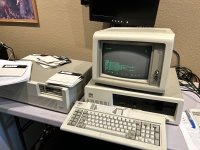
Based on poking around the internet, I had thought the hard disks in this computer were ESDI, but turns out they are MFM hard disks. My computer has two 42MB hard disks that the software manages as one logical disk. I believe the disk part # is 080885-ESP145-0665-53, and searching for 0665-53 turns up info on these disks. I believe these same disks may have been used in IBM AT machines.
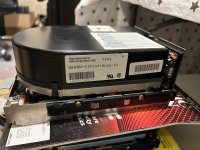
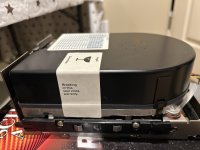
So - being MFM disks, I figured I'd try David Gesswein's MFM emulator to read/image these drives. Imaging them worked flawlessly as best I can tell. Here's the log of reading the first disk.
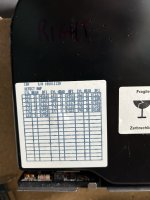
Here's the emulator cabled for reading a hard disk.
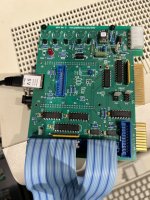
After successfully backing up both disks, I went ahead and performed the SSP V5 upgrade, which went great. I backed up the disks again with the V5 software.
I thought I would see how the emulator worked with the System/36.
I converted both of the extracted data file backups to emufiles w/the below commands:
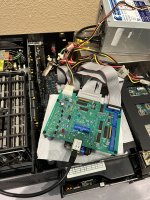


I followed David's instructions on how to set up the emulator to automatically start up on power up, and shutdown on power off. This involves using systemctl to enable the emulator as a service that starts up when the os boots, and changing the jumper on P9 to "Fill" to allow the hardware to charge the capacitors, that then provide power for the os to shut down gracefully when power to the emulator is lost. This feature works great, and allows you to put the emulator in a computer w/no access to the hardware, and it starts up and shuts down just fine on its own. It seems to start up very fast, about 12 seconds for me. I did add the optional step to have the emulator back-up the emulator files each time it starts up. I have it keeping 4 backups. I figure if I ever completely mess up my 5364 software, I can restore a previous backup to recover.
One note to be aware of - if you have upgraded to the latest beaglebone image, some of the directories have changed slightly from the instructions... for example:
The 5364 runs so much quieter without the two full height MFM hard disks, and performance appears identical, although that is a subjective judgement as I have done no testing of the relative performance.
Here's the S/36 running off the mfm emulator. I've done about a total of 4 hours of testing across a week, and so far the emulator is working perfectly. At some point I want to test the experimental write feature of the mfm emulator to write my emulated drives back to the physical disks to see how that works, but for now I'm happy having a quiet and reliable 5364 to use.

Pete

Based on poking around the internet, I had thought the hard disks in this computer were ESDI, but turns out they are MFM hard disks. My computer has two 42MB hard disks that the software manages as one logical disk. I believe the disk part # is 080885-ESP145-0665-53, and searching for 0665-53 turns up info on these disks. I believe these same disks may have been used in IBM AT machines.


So - being MFM disks, I figured I'd try David Gesswein's MFM emulator to read/image these drives. Imaging them worked flawlessly as best I can tell. Here's the log of reading the first disk.
The bad block list exactly matched the printed back block list from the top of the hard disk which gave me a lot of confidence.debian@BeagleBone:/opt/mfm$ mfm_read --analyze --transitions_file sys36_right_transitions --extracted_data_file sys36_right_drive_extracted_data
Board revision C detected
Found drive at select 2
Drive RPM 3599.5
Found matching format Intel_iSBC_214_256B: good count difference 0
Interleave mismatch previous entry 0, 8 was 8 now 0
Selected head 8 found 0, last good head found 6
Read errors trying to determine sector numbering, results may be in error
Number of heads 7 number of sectors 32 first sector 0
Unable to determine interleave. Interleave value is not required
Drive supports buffered seeks (ST412)
Disk has recalibrated to track 0
Stopping end of disk search due to recalibration
Number of cylinders 733, 42.0 MB
Command line to read disk:
--format Intel_iSBC_214_256B --sectors 32,0 --heads 7 --cylinders 733 --header_crc 0xffff,0x1021,16,0 --data_crc 0xffffffff,0x140a0445,32,6 --sector_length 256 --retries 50,4 --drive 2
Bad block set on cyl 223, head 2, sector 29
Bad block set on cyl 366, head 3, sector 30
Bad block set on cyl 367, head 3, sector 30
Bad block set on cyl 368, head 3, sector 30
Bad block set on cyl 369, head 3, sector 30
Bad block set on cyl 370, head 3, sector 30
Bad block set on cyl 371, head 3, sector 30
Bad block set on cyl 372, head 3, sector 30
Bad block set on cyl 373, head 3, sector 30
Bad block set on cyl 374, head 3, sector 30
Bad block set on cyl 375, head 3, sector 30
Bad block set on cyl 376, head 3, sector 30
Bad block set on cyl 377, head 3, sector 30
Bad block set on cyl 590, head 5, sector 5
Bad block set on cyl 616, head 5, sector 30
Bad block set on cyl 641, head 2, sector 23
Found cyl 0 to 732, head 0 to 6, sector 0 to 31
Expected 164192 sectors got 164176 good sectors, 0 bad header, 0 bad data
16 sectors marked bad or spare
0 sectors corrected with ECC. Max bits in burst corrected 0
Track read time in ms min 28.741375 max 722.401875 avg 36.591816

Here's the emulator cabled for reading a hard disk.

After successfully backing up both disks, I went ahead and performed the SSP V5 upgrade, which went great. I backed up the disks again with the V5 software.
I thought I would see how the emulator worked with the System/36.
I converted both of the extracted data file backups to emufiles w/the below commands:
I mounted the emulator in one of the drive bays using a 3d printed model I found here: https://www.tinkercad.com/things/4DHmHDMOgek-st506-simulator-mount-5-without-faceplate I stole the sleds from one of the hard disks and used those to mount the bracket w/the emulator mounted to it. When using the emulator w/this computer, the control cable should have no twist, and connect to J2. The Drive A connector to J1, and Drive B to J6 (need a 20 pin female to 20 pin female for this one). Leave the P7 and P8 set to drive 1 and drive 2.ext2emu -h 7 -c 733 -f Intel_iSBC_214_256B -e sys36_right_drive_extracted_data -m sys36_right_emufile
ext2emu -h 7 -c 733 -f Intel_iSBC_214_256B -e sys36_left_drive_extracted_data -m sys36_left_emufile



I followed David's instructions on how to set up the emulator to automatically start up on power up, and shutdown on power off. This involves using systemctl to enable the emulator as a service that starts up when the os boots, and changing the jumper on P9 to "Fill" to allow the hardware to charge the capacitors, that then provide power for the os to shut down gracefully when power to the emulator is lost. This feature works great, and allows you to put the emulator in a computer w/no access to the hardware, and it starts up and shuts down just fine on its own. It seems to start up very fast, about 12 seconds for me. I did add the optional step to have the emulator back-up the emulator files each time it starts up. I have it keeping 4 backups. I figure if I ever completely mess up my 5364 software, I can restore a previous backup to recover.
One note to be aware of - if you have upgraded to the latest beaglebone image, some of the directories have changed slightly from the instructions... for example:
is now:cd ~/mfm
./setup_mfm_read
cd /opt/mfm
./setup_mfm_read
The 5364 runs so much quieter without the two full height MFM hard disks, and performance appears identical, although that is a subjective judgement as I have done no testing of the relative performance.
Here's the S/36 running off the mfm emulator. I've done about a total of 4 hours of testing across a week, and so far the emulator is working perfectly. At some point I want to test the experimental write feature of the mfm emulator to write my emulated drives back to the physical disks to see how that works, but for now I'm happy having a quiet and reliable 5364 to use.

Pete
